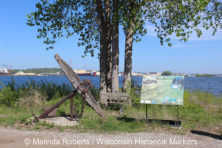History Along the Shore
- Share
- Tweet
- Pin
- Share

by MYLES DANNHAUSEN SR.
President of the Egg Harbor Historical Society.
This summer I joined some of my kids and grandkids for what has become a summer family tradition when kids come home for vacation – a simple pontoon boat rental excursion along the Green Bay shore.
We left the dock in Sister Bay and headed north passing some of the summer “cottages” along the shore, admiring their private harbors and stairs leading from grand residences to the shoreline. But a few miles further the evidence of development ceased, and we found ourselves gazing in awe at an outcropping of the Niagara Escarpment that extends down to the water and offers no way to access the shore. Today this outcropping is preserved as Ellison Bluff County Park.
Just around the bend to the north the bluffs diminish to reveal another of the peninsula’s many inlets, Ellison Bay. And further north still there’s more magnificent untouched escarpment, now known as Door Bluff Headlands County Park. These geological features are the historical Door Peninsula that indigenous people and early fur traders saw after skirting the shores of Upper Michigan or venturing north from the Fox River.
I imagined myself as an ancient visitor to the peninsula in a small canoe, furiously paddling away from a brewing storm. To the west you see nothing but open water as far as the eye could see. To the east you find either towering bluffs or rocky shores. Do you turn around and try to scale the escarpment, or seek refuge in an equally foreboding inlet? Some chose an inlet and never left.
This little family adventure reminded me that most of the early history of the Door Peninsula revolves around its shoreline, because, according to Hjalmar Holand, there were no roads crisscrossing the entire county prior to 1856. Indigenous settlements and early food traders accessed the shore from the water. When demand for lumber increased, permanent settlements emerged. These were also serviced by boats that ventured in and out of the many inlets that dot the Door County peninsula rather than by roads and trails. Later, towns which began as logging outposts and staging areas welcomed steamships full of summer visitors. Today a few enclaves still host the dwindling commercial fishing operations that once thrived on the peninsula.
For this reason the best way to experience the early history of the peninsula – and understand why this place has captivated so many visitors – is to navigate the entire peninsula by boat. If you started from south of Sturgeon Bay and headed north, writing narratives on all the inlets and islands along the way, by the time you got to Egg Harbor you could write volumes.
There may be no better way to grasp the history, the present and the magnificence of this peninsula than by viewing it from the shore.
As our pontoon excursion neared its end, I noticed my 10-year-old granddaughter asking questions about interesting houses new and old as she spotted them along the shore. I see the excitement on my 3-year-old grandson’s face as he spots pelicans and looks for eagles.
“What is that building for?”
“Why is that house there?”
“What are those rocks?”
Unending questions, and an entry point to teach a new generation about the stories of the past.



